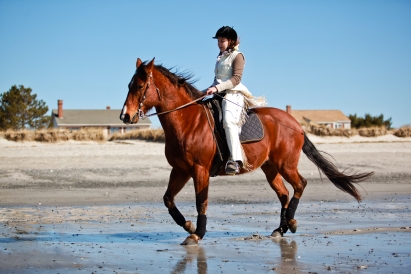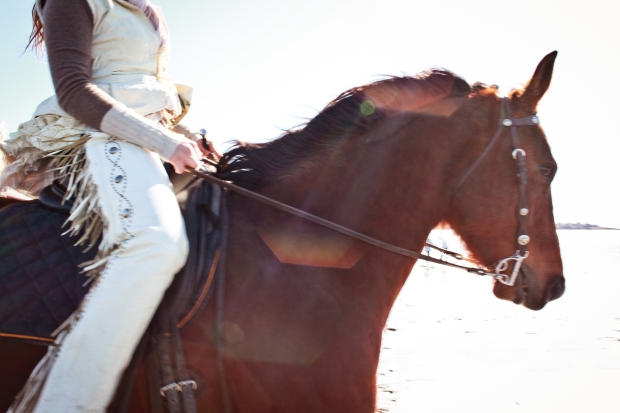Previously, I listed three key ingredients that I feel are important to develop as a rider. We have discussed the importance of straightness, and now it is time to focus on the value of breathing properly, and the development and use of ones “core.” When I use the term “core,” I’m not talking about developing a six pack, or the need to have super strong abs. Some “traditional” core strength is very helpful, but my focus in this article will be on developing your core energetically. Learning to release tension in your body and breathe more effectively will make a HUGE difference in the quality of communication you have with your horse – whether you are riding, or working with them on the ground. It will also improve every other aspect of your life. This may sound grandiose and abstract, but it really isn’t. The quality of energy, centering and breathing that is beneficial in horsemanship can be learned through many traditional martial arts techniques – and there are many books, videos, and clinics out there now that make that very connection. Two of my favorite trainers and writers have really focused on this connection. Mark Rashid, noted natural horsemanship trainer, has integrated Aikido principles into his teaching, and I recommend you read some of his books, attend a clinic, and/or watch some of his videos on the subject. Mark Russell, a trainer that works within the world of “natural dressage,” uses the principles of Tai Chi in his teaching. He also holds clinics, and has produced interesting videos and articles on using Tai Chi to improve your riding.
Too often, I see tense riders that have forgotten how to breathe. These riders have a center of balance that is very high in their shoulders, and unfortunately their horses mirror that tense energy and are often also not breathing properly. Mark Russell uses the visual of a pyramid to explain this concept. When we are tense as riders, not breathing properly and not using our core effectively, we are essentially shaped like an upside down pyramid. Our breathing and balance are up in our shoulders, we are too “in our head”, and being that top heavy does not center us on our horse. When you breathe in and out of your chest, it is very hard to take deep breaths. Too much thinking, and not enough feeling exacerbate this imbalance. The goal is to be an upright pyramid. This is a much more grounded, balanced position, and really allows us to ride our horses in a much more harmonious way. But how do you accomplish this??
The first step is to focus on bringing your energy down below your belly button. This is bringing your energy down into your “core.” While standing unmounted, practice loosening your shoulders, softening your knee and hip joints, and taking deep breaths that expand and contract your belly below your belly button, at approximately where the top of your hip bones are. Focus on the image of an upright pyramid, and feel the centering weight travel lower in your body, so that your stability mimics that of the base heavy pyramid. Mark Russell describes this process as rooting – and think of it in just this way – imagine roots extending out of your feet that figuratively ground you. As you practice this on the ground, have someone try to gently push on you before and after you focus on bringing your center of balance lower. You should feel a marked improvement in your stability. This improvement will carry over into your riding as well, it might take a bit of practice for it to feel natural, but in time it will.
The first step in improving is awareness. You will find that if you just pay attention to staying softer, and breathing deeper while you ride, you will improve. Remember to always check the tension in your joints, keep them open and supple. Breathe deep and low, and focus on bringing yourself out of your “thinking brain” and into your “feeling body.” Imagine that you are not just centering yourself “over” your horse, but rather center yourself “through” your horse, deep into the ground. Remember that the horse will mirror the energy, breath and softness of the rider or handler. So if they are tense, you are likely tense as well, and vice versa. As with anything, the proof is in the pudding, so just play with these concepts, and I bet you will feel a difference.
One of the benefits to improving our breathing, balance and core control is that then we can use intentional tension as a tool through the concept of a half halt. For years, the term “half halt” was this mystical concept that my instructors always barked at me, but never bothered to truly define. I never asked any of them what they really meant, because it was always implied that I should know. I know that this was a failing on my part in my role as a student, but honestly, I am not sure that my instructors would really have been able to explain it to me anyways. When I ask my students now if they understand what a half halt is, how it is executed, and what the purpose is, I get many responses, but most are muddy at best. Most often, people describe the half halt as a momentary squeezing/tightening of the reins accompanied by leg aids. Some emphasize that it is the inside leg and outside rein, some define it a bit differently, but most definitions miss the true point of a half halt.
Most commonly seen in the world of dressage, the half halt is a skill that is used by all good horse people, whether they know it as such or not. At its simplest, it is a momentary resistance by the rider against the horses energy. It can be used to rebalance a horse before executing a new movement, it can be used to recycle the energy of the horse and lighten the forehand and add more energy to the hindquarters, and it can be a call to attention to the inattentive horse. The half halt MUST start in the core though, for it to be truly effective. I teach my students to engage their core momentarily. If you are doing this properly, you will feel taller for a moment – so sometimes it is helpful to imagine that you are pushing your belly button upward and outward, without hollowing your back. This moment of resistance must be just that – a moment. Continual bracing will get you nowhere, but you can repeat after releasing. Depending on how sensitive the horse is to this aid, the resistance can travel down your outside arm, or both arms, into the reins and to the horses mouth. If you execute your half halt in this
way – from your core to the horses mouth versus just pulling on the reins, you are staying grounded and centered and can utilize that strength to accomplish more with less. I find that if you approach your half halts this way, you will need less of the “driving aid” that so often accompanies most definitions of the half halt. Play with your horse, and you can find the exact formula that works for you, but remember that it must come from the core first, and must be momentary. This momentary application of tension, or resistance, will only be effective if it contrasts with your regular riding position, which brings us back full circle to why it is so important to breathe deep, center yourself, stay soft and ride!

Still too bracey in the poll, because I was not centered enough, and was relying too much on my reins…


Reblogged this on SYSTEMA SLC and commented:
Whether or not you are a horseback rider, this is article is a concise and informative work that shows “Tai Chi in practice.” I don’t often see Tai Chi principles “used,” but I love it and I think it is the only way to practice Tai Chi (or Systema for that matter.) My Tai Chi instructor, Bill Parkinson, often compared our bodies with horses. Bill would say, our spirit needs a healthy horse to lead us to the afterlife. As I have only ridden a horse once or twice in my life, I read this article with my physical self in mind rather than a horse.
I was also reminded of what Mark Zamarin teaches about how our emotional and physical state effects those around us. When we are tense, those around us will respond with tension. As such, we can use tension and relaxation to communicate with our training partners (consider the “half-halt” mentioned in the article,) but to do so, we must first know how to control tension in ourselves.
I would like to reiterate an exercise we use in Systema to understand and control tension.
While lying or standing, relax and breath in through the nose and out through the mouth. Inhale slowly and tense up the body starting with the head all the way down to the feet. Feel every muscle tense up in a wave-like motion down to the feet. Go slow. When the entire body is tense, pause and exhale as you relax the body from head to feet. Now inhale and tense the feet all the way up to the head, pause when every muscle is tense, then exhale and relax the feet all the way up to the head. You must time your inhales and exhales with the rate that you tense up or relax your body. Next practice rapid inhales and exhales. Inhale and tense the whole body at once, exhale and relax the whole body at once. Exhaling through the mouth will help disperse tension quickly.
This exercise teaches us to recognize the difference between relaxation and tension so we become aware when tension arises. It also teaches us to use the breath to control tension. Inhalation is a naturally tense action and exhalation is naturally relaxing (sighing or the sound “shh, for example.)
Thanks!